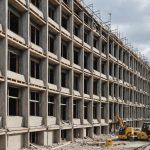Your Ultimate Guide to Securing Planning Permission for Property Modifications in the UK
When you decide to make significant changes to your home or property, whether it’s a simple extension or a major renovation, understanding the planning permission process is crucial. Here’s a comprehensive guide to help you navigate through the complexities and ensure your project gets the green light from your local planning authority.
Understanding Planning Permission and Permitted Development
Before diving into the application process, it’s essential to know the difference between planning permission and permitted development.
Also to read : How Fluctuating Mortgage Rates Impact Buy-to-Let Property Investments in the UK
What is Planning Permission?
Planning permission is a formal decision from your local planning authority that your proposed development complies with the local planning policies and regulations. You need planning permission for most building projects, especially those that involve significant changes to your property.
What is Permitted Development?
Permitted development rights allow you to carry out certain types of work without needing to apply for planning permission. These rights vary depending on the type of property and its location. For example, you might be able to build a home extension under permitted development, but there are strict guidelines and limits on size and height.
Also read : Essential Factors UK Landlords Should Keep in Mind for Successful Rent-to-Own Initiatives
Determining if You Need Planning Permission
Not all property modifications require planning permission, but it’s always better to check. Here are some scenarios where you might need planning permission:
- Building an Extension: If your extension exceeds the permitted development limits (e.g., more than 8 meters from the rear wall for detached houses or more than 6 meters for semi-detached or terraced houses), you will need planning permission.
- Changing the Use of Your Property: If you plan to change the use of your property, such as converting a residential house into a commercial space, you will need planning permission.
- Working on a Listed Building: Any work on a listed building, even if it’s minor, typically requires planning permission and often additional approvals.
- Major Renovations: Significant changes to the structure or appearance of your property, such as adding a new floor or altering the facade, will usually require planning permission.
Preparing Your Planning Application
Preparing a thorough and well-documented planning application is key to a successful outcome. Here are the steps you should follow:
Step 1: Consult Your Local Planning Authority
Before submitting your application, it’s a good idea to consult with your local planning authority. They can provide guidance on whether your project needs planning permission and what specific requirements you need to meet.
Step 2: Gather Necessary Documents
You will need to gather several documents, including:
- Detailed Plans and Drawings: These should include elevations, floor plans, and cross-sections of your proposed development.
- Design and Access Statement: This explains how your development meets the local planning policies and how it will impact the surrounding area.
- Neighbour Consultation: You may need to consult with your neighbours, especially if your project could affect them.
- Environmental Impact Assessment: For larger projects, you might need to conduct an environmental impact assessment.
Step 3: Submit Your Application
Once you have all the necessary documents, you can submit your application. This can usually be done online through the local planning authority’s website or in person.
The Planning Application Process
Here’s what happens after you submit your application:
Initial Review
The local planning authority will review your application to ensure it is complete and meets the necessary requirements.
Public Consultation
Your application will be made public, and neighbours, local residents, and other stakeholders will have the opportunity to comment or object.
Assessment
The planning authority will assess your application against local planning policies, building regulations, and other relevant factors.
Decision
The planning authority will make a decision based on the assessment. This can be approved, approved with conditions, or refused.
Building Regulations and Compliance
In addition to planning permission, you also need to comply with building regulations. Here’s what you need to know:
What are Building Regulations?
Building regulations set standards for the design and construction of buildings to ensure they are safe, accessible, and energy-efficient.
Key Areas of Compliance
- Structural Integrity: Ensuring the building is structurally sound.
- Fire Safety: Meeting fire safety standards.
- Energy Efficiency: Complying with energy efficiency requirements.
- Accessibility: Ensuring the building is accessible for people with disabilities.
Permitted Development Rights: A Detailed Guide
Here is a detailed look at permitted development rights and what they cover:
Home Extensions
- Rear Extensions: Up to 8 meters for detached houses and up to 6 meters for semi-detached or terraced houses.
- Side Extensions: Must be no more than half the width of the original house.
- Front Extensions: Generally not permitted under permitted development.
Other Permitted Developments
- Loft Conversions: Permitted as long as they do not extend beyond the plane of the existing roof slope.
- Garage Conversions: Permitted if the work is internal and does not alter the exterior appearance.
- Outbuildings: Permitted if they are no larger than 50% of the land around the original house.
Common Pitfalls and How to Avoid Them
Here are some common pitfalls and tips on how to avoid them:
Lack of Consultation
- Consult Neighbours: Early consultation can prevent objections and make the process smoother.
- Consult Local Authority: Pre-application advice can help you understand what is likely to be approved.
Incomplete Applications
- Ensure All Documents Are Included: Missing documents can delay or even reject your application.
- Double-Check Plans: Ensure plans are accurate and detailed.
Non-Compliance with Regulations
- Understand Local Policies: Familiarize yourself with local planning policies and building regulations.
- Seek Professional Advice: If you’re unsure, consult with architects, planners, or solicitors.
Practical Insights and Actionable Advice
Here are some practical tips to help you through the process:
Hire a Professional
If you’re not experienced in planning applications, hiring a professional can save you time and stress.
Keep Neighbours Informed
Good neighbourly relations can go a long way in avoiding objections.
Be Flexible
Be prepared to make changes based on feedback from the planning authority or neighbours.
Example Scenarios and Case Studies
Here are a few example scenarios to illustrate the process:
Scenario 1: Building a Home Extension
- Project Details: A homeowner wants to build a rear extension that is 7 meters long.
- Outcome: Since this is within the permitted development limits, no planning permission is required, but the homeowner must still comply with building regulations.
Scenario 2: Converting a Loft
- Project Details: A homeowner wants to convert their loft into an additional bedroom.
- Outcome: This is generally permitted under permitted development rights, but the homeowner must ensure the work does not extend beyond the plane of the existing roof slope.
Table: Comparison of Planning Permission and Permitted Development
| Aspect | Planning Permission | Permitted Development |
|---|---|---|
| When Required | Significant changes to property, change of use, major renovations | Minor changes, home extensions within limits, loft conversions |
| Application Process | Formal application to local planning authority | No application needed if within permitted limits |
| Public Consultation | Neighbours and public can comment or object | No public consultation required |
| Decision Timeframe | Typically 8-13 weeks | Immediate if within permitted limits |
| Compliance | Must comply with local planning policies and building regulations | Must comply with building regulations and permitted development rules |
Quotes from Experts
- “Understanding the difference between planning permission and permitted development is crucial. It can save you a lot of time and hassle if you know what you can do without needing permission,” says Jane Smith, a planning consultant.
- “Always consult with your local planning authority before starting any project. They can provide valuable guidance and help you avoid common pitfalls,” advises John Doe, a local planner.
Securing planning permission for property modifications in the UK can be a complex process, but with the right information and preparation, you can navigate it successfully. Remember to consult your local planning authority, ensure your application is complete, and comply with all relevant regulations. Whether you’re building an extension, converting a loft, or changing the use of your property, understanding the rules and seeking professional advice when needed can make all the difference in getting your project approved.











